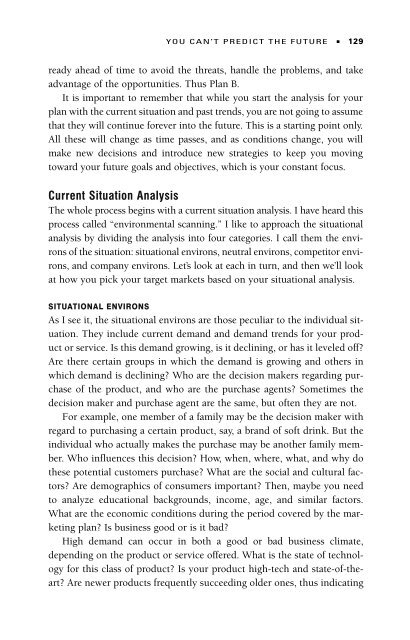A Class with Drucker - Headway | Work on yourself
A Class with Drucker - Headway | Work on yourself
A Class with Drucker - Headway | Work on yourself
Create successful ePaper yourself
Turn your PDF publications into a flip-book with our unique Google optimized e-Paper software.
YOU CAN’T PREDICT THE FUTURE ■ 129<br />
ready ahead of time to avoid the threats, handle the problems, and take<br />
advantage of the opportunities. Thus Plan B.<br />
It is important to remember that while you start the analysis for your<br />
plan <str<strong>on</strong>g>with</str<strong>on</strong>g> the current situati<strong>on</strong> and past trends, you are not going to assume<br />
that they will c<strong>on</strong>tinue forever into the future. This is a starting point <strong>on</strong>ly.<br />
All these will change as time passes, and as c<strong>on</strong>diti<strong>on</strong>s change, you will<br />
make new decisi<strong>on</strong>s and introduce new strategies to keep you moving<br />
toward your future goals and objectives, which is your c<strong>on</strong>stant focus.<br />
Current Situati<strong>on</strong> Analysis<br />
The whole process begins <str<strong>on</strong>g>with</str<strong>on</strong>g> a current situati<strong>on</strong> analysis. I have heard this<br />
process called “envir<strong>on</strong>mental scanning.” I like to approach the situati<strong>on</strong>al<br />
analysis by dividing the analysis into four categories. I call them the envir<strong>on</strong>s<br />
of the situati<strong>on</strong>: situati<strong>on</strong>al envir<strong>on</strong>s, neutral envir<strong>on</strong>s, competitor envir<strong>on</strong>s,<br />
and company envir<strong>on</strong>s. Let’s look at each in turn, and then we’ll look<br />
at how you pick your target markets based <strong>on</strong> your situati<strong>on</strong>al analysis.<br />
SITUATIONAL ENVIRONS<br />
As I see it, the situati<strong>on</strong>al envir<strong>on</strong>s are those peculiar to the individual situati<strong>on</strong>.<br />
They include current demand and demand trends for your product<br />
or service. Is this demand growing, is it declining, or has it leveled off?<br />
Are there certain groups in which the demand is growing and others in<br />
which demand is declining? Who are the decisi<strong>on</strong> makers regarding purchase<br />
of the product, and who are the purchase agents? Sometimes the<br />
decisi<strong>on</strong> maker and purchase agent are the same, but often they are not.<br />
For example, <strong>on</strong>e member of a family may be the decisi<strong>on</strong> maker <str<strong>on</strong>g>with</str<strong>on</strong>g><br />
regard to purchasing a certain product, say, a brand of soft drink. But the<br />
individual who actually makes the purchase may be another family member.<br />
Who influences this decisi<strong>on</strong>? How, when, where, what, and why do<br />
these potential customers purchase? What are the social and cultural factors?<br />
Are demographics of c<strong>on</strong>sumers important? Then, maybe you need<br />
to analyze educati<strong>on</strong>al backgrounds, income, age, and similar factors.<br />
What are the ec<strong>on</strong>omic c<strong>on</strong>diti<strong>on</strong>s during the period covered by the marketing<br />
plan? Is business good or is it bad?<br />
High demand can occur in both a good or bad business climate,<br />
depending <strong>on</strong> the product or service offered. What is the state of technology<br />
for this class of product? Is your product high-tech and state-of-theart?<br />
Are newer products frequently succeeding older <strong>on</strong>es, thus indicating


